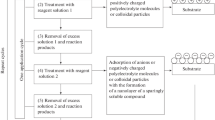Abstract
The estimation of electrochemical quartz crystal microbalance (EQCM) frequencies from a given cyclic voltammetric data is analysed using underpotential deposition (UPD) of metals as an illustrative process. The crucial role played by the surface roughness of electrodes and electrosorption valency of the depositing species is pointed out. The computed EQCM frequency shifts for the UPD of Cd and Tl on polycrystalline Ag electrodes are in satisfactory agreement with the experimental data.




Similar content being viewed by others
Notes
Figures 1c and 3c from ref. [19] depict the surface coverages as a function of potential albeit only the deposition process. Surface coverage, θ, is defined as θ i =Δq idep /qmax where qmax=ze/(2r)2, z denotes the valency of the species, e is the electronic charge, Δqdep is the charge density corresponding to the appropriate potentials evaluated using Eqns. 1 and 2 and r is the ionic radii of the depositing species [23] (r=0.95 Å for Cd2+ and 1.5 Å for Tl+. The plots of surface coverage, θ vs E plot so deduced are in excellent agreement with those of Ref. [19], thus validating the Scheme 1 for computing charge densities.
References
Varineau PT, Buttry DA (1987) J Phys Chem 91:1292
Bruckenstein S, Robert Hillman A (1998) J Phys Chem B 102:10826
Baek Y, Frankel GS (2003) J Electrochem Soc 150:B1
Kutner W, Noworyta K, Marczak R, D’Souza F (2002) Electrochim Acta 47:2371
Ebara Y, Okahata Y (1994) J Am Chem Soc 116:1209
Deakin MR, Melroy O (1988) J Electroanal Chem 239:321
Lay MD, Varazo K, Srisook N, Stickney JL (2003) J Electroanal Chem 221:554–555
Buttry DA, Ward MD (1992) Chem Rev 92:1335
Schumacher R (1990) Angew Chem Int Ed Engl 29:329
In order to obtain accurate estimates of the charge densities for the entire potential window of the cyclic voltammogram, the current density was noted at an interval of 2.5 s
Bard AJ, Faulkner LR (1980) Electrochemical methods,chap. 6. Wiley, New York
Motheo AJ, Machado SAS, Van Kampen MH, Santos JR Jr (1993) J Braz Chem Soc 4:122
Rama Kant (1993) Using the current transients, the structure factor of one and two—dimensional rough surfaces can be deduced as an inverse problem. Phys Rev Lett 70:4094
Saurbrey G (1959) Z Phys .155:206 Among various equations describing the relationship between the resonant frequency of an oscillating piezoelectric crystal and the mass deposited, Saurbrey equation is the most widely accepted. However, similar equations have been derived by Stockridge (Stockbridge CD (1966) Vac Microbalance Tech 5:193) and Lostis (Lostis M (1958) PhD Faculty of Science, University of Paris)
Zhang J, Sung YE, Rikvold PA (1996) J Chem Phys 104:5699
Blum L, Huckaby DA, Legault M (1996) Electrochim Acta 41:2207
See for example: Huckaby DA, Blum L (1994) Diffusion processes: experiment, theory, simulations. In Pekalski A (ed) Proceedings of the fifth Max Born symposium, Kudowa, Poland Springer, Berlin Heidalberg New York
Schultze JW, Vetter KJ (1973) J Electroanal Chem 44:63
Tang Y, Furtak TE (1991) Electrochim Acta 36:1873
GIMP is an acronym for the GNU Image Manipulation Program and is a freely available software, capable of functioning under a variety of operarting systems for image authoring and image format conversion. In the present study, GIMP has been employed to obtain accurate numerical estimates of current–potential data from appropriate cyclic voltammograms. These values are then used to obtain the corresponding charge densities
Waszczuk P, Wnuk A, Sobkowski J (1996) Electrochim Acta 44:1789
Daujotis V, Gaidamauskas E (1998) J Electroanal Chem 446:151
Lide DR (ed) (2000) CRC Handbook of chemistry and physics, 80th edn. CRC Press, New York
Schumacher R, Borges G, Kanazawa KK (1985) Surf Sci 163:L621
Schumacher R, Gordon JG, Melroy O (1987) J Electroanal Chem 216:127
Bort H, Juttner K, Lorenz WJ, Staikov G (1983) Electrochim Acta 28:993
Jovic VD, Jovic BM (2002) Electrochim Acta 47:1777 (and references therein)
The electrosorption valency γ pertaining to the UPD of Cd on Au is reported to vary from 1.6 to 2.0 and γ in the case of the UPD of Cd on Ag is ≈ 2.0. A value of 1.7 for γ has been employed in our analysis leading to Fig. 2c. If γ is assumed to be 2.0, an error of ca ±15% is obtained in comparison with experimental data
(a) The electrosorption valency (γ) of ions and chemisorbing organic compounds is a measure of the extent of partial charge transfer of the adsorbate with the electrode surface. Within a statistical mechanical framework, the estimation of γ requires suitable adsorption isotherms and models for interfacial potential distribution (Schultze JW, Koppitz FD (1976) Electrochim Acta 21:327). Alternately, quantum mechanical calculations as well as Monte Carlo simulations pertaining to simple halide ions do exist (see for example: Abou Hamad I, Wandlowski Th, Brown G, Rikvold PA(2003) J Electroanal Chem 211:554–555) (b) It is interesting to enquire whether employing the roughness factor and electrosorption valency from the experimental data is appropriate in deducing EQCM response from the CV data while employing Eqs. 8 and 9. However, the roughness factor of any electrode can directly be obtained by estimating the oxide formation on the surface. Analogously, the electrosorption valency of depositing species can be deduced from suitable adsorption isotherms
The experimental data of Figs. 1 and 2 were reproduced with permission from Elsevier Science Publishers
Acknowledgement
The financial support by the Council of Scientific and Industrial Research, Government of India is gratefully acknowleged.
Author information
Authors and Affiliations
Corresponding author
Rights and permissions
About this article
Cite this article
Girija, T.C., Sangaranarayanan, M.V. Estimation of electrochemical quartz crystal microbalance frequencies from cyclic voltammetric data:—underpotential deposition of metals as an illustration. J Solid State Electrochem 9, 621–626 (2005). https://doi.org/10.1007/s10008-004-0617-7
Received:
Revised:
Accepted:
Published:
Issue Date:
DOI: https://doi.org/10.1007/s10008-004-0617-7




